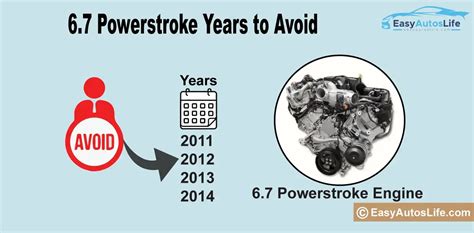Avoid 2003, 2004, and early 2005 Powerstroke engines due to common injector, turbocharger, and head gasket issues.

What Year Powerstroke to Avoid: A Comprehensive Guide
Introduction
The Powerstroke diesel engine, manufactured by Ford Motor Company, has been a popular choice among truck enthusiasts for decades, known for its durability, power, and torque. However, like any mechanical system, certain model years of the Powerstroke engine have been plagued by various issues and problems, causing headaches for owners and potential buyers. In this comprehensive guide, we will delve into the intricacies of the Powerstroke engine, identifying the years that are best avoided and providing detailed explanations for each. Whether you are a seasoned truck owner or a prospective buyer, this article will arm you with valuable information to make an informed decision and steer clear of potential pitfalls.
Identifying the Problem Years
The Powerstroke engine has seen its fair share of challenges over the years. Certain model years stand out as particularly problematic, exhibiting a higher incidence of mechanical issues, design flaws, and recurring problems. While some issues may be minor and easily resolved, others can be severe, leading to costly repairs or even engine failure. Being aware of these problem years can help you avoid potential headaches and choose a more reliable Powerstroke-equipped truck.
6.0L Powerstroke (2003-2007)
The 6.0L Powerstroke, introduced in 2003, is often considered the most problematic Powerstroke engine. It was plagued by numerous issues, including:
-
EGR System Problems: The EGR (Exhaust Gas Recirculation) system is prone to failure, leading to decreased engine performance and potential turbocharger damage.
-
Injector Problems: Injector failure is a common issue, causing rough idling, poor fuel economy, and increased emissions.
-
Turbocharger Problems: Turbocharger failures are not uncommon, resulting in reduced power and increased maintenance costs.
-
Head Gasket Failure: Head gasket failure is a severe problem that can cause coolant and oil mixing, leading to catastrophic engine damage.
6.4L Powerstroke (2008-2010)
The 6.4L Powerstroke, a successor to the troubled 6.0L, was also plagued by several issues:
-
Injector Problems: Injector failure remained a persistent issue, causing similar problems as seen in the 6.0L.
-
Turbocharger Problems: Turbocharger failures continued to occur, leading to reduced power and increased repair costs.
-
DPF (Diesel Particulate Filter) Problems: The DPF system is prone to clogging, causing decreased engine performance and potential regeneration issues.
-
Oil Cooler Failure: Oil cooler failure is a severe problem that can lead to engine overheating and potential catastrophic damage.
2011 6.7L Powerstroke
The early production models of the 2011 6.7L Powerstroke exhibited a few initial problems:
-
Injector Problems: Injector issues were still present, causing similar problems as seen in previous years.
-
Turbocharger Problems: Turbocharger failures continued to occur, albeit to a lesser extent than in previous years.
-
CP4 High-Pressure Fuel Pump Failure: The CP4 high-pressure fuel pump, a critical component of the fuel system, was prone to failure, causing a loss of power and potential engine damage.
Understanding the Underlying Causes
The problems experienced by certain Powerstroke engines can be attributed to various factors, including design flaws, manufacturing defects, and improper maintenance practices.
-
Design Flaws: Some of the issues stem from inherent design flaws, such as the EGR system's vulnerability to soot buildup and the tendency of the turbochargers to overheat.
-
Manufacturing Defects: Manufacturing defects, such as faulty injectors or weak head gaskets, can also contribute to problems.
-
Improper Maintenance: Inadequate maintenance, such as neglecting regular oil changes or using low-quality fuel, can exacerbate existing issues and lead to premature failures.
Avoiding the Problem Years: A Practical Guide
To avoid the potential pitfalls associated with the problem years of the Powerstroke engine, consider the following strategies:
-
Choose a Different Model Year: Opting for a Powerstroke engine from a more reliable model year, such as the 2015+ 6.7L Powerstroke, can significantly reduce the risk of encountering major issues.
-
Thorough Research: Conduct extensive research on the specific model year and engine you are considering, reading reviews, consulting forums, and seeking advice from experienced owners.
-
Pre-Purchase Inspection: Before making a purchase, have the vehicle inspected by a qualified mechanic who is familiar with Powerstroke engines. This inspection can uncover hidden problems and potential red flags.
-
Regular Maintenance: Follow the manufacturer's recommended maintenance schedule religiously, using high-quality fluids and parts. Regular maintenance can help prevent problems from developing or worsening.
Conclusion
The Powerstroke engine has a rich history and a loyal following among truck enthusiasts. However, certain model years have been marred by various issues and problems, causing frustration and financial burdens for owners. By understanding the problem years, their underlying causes, and the strategies to avoid them, you can make an informed decision when choosing a Powerstroke-equipped truck. Remember, proper research, careful selection, and diligent maintenance are key to enjoying a reliable and trouble-free ownership experience with a Powerstroke diesel engine.


